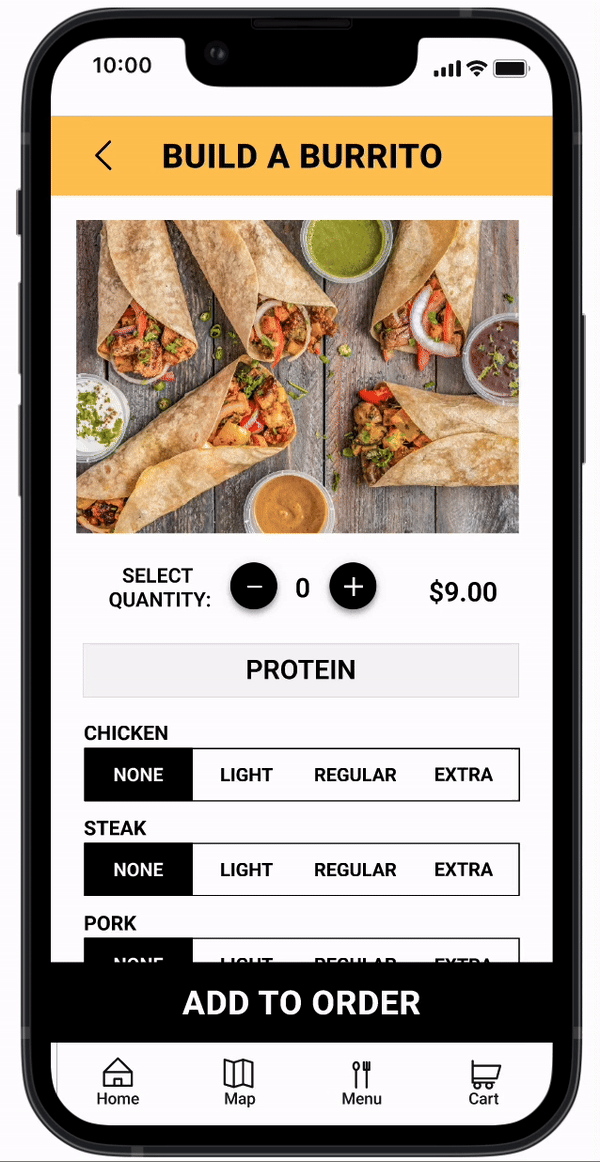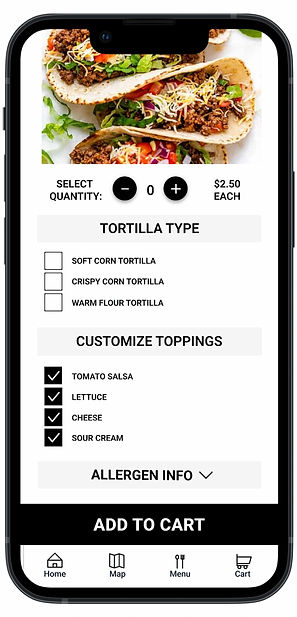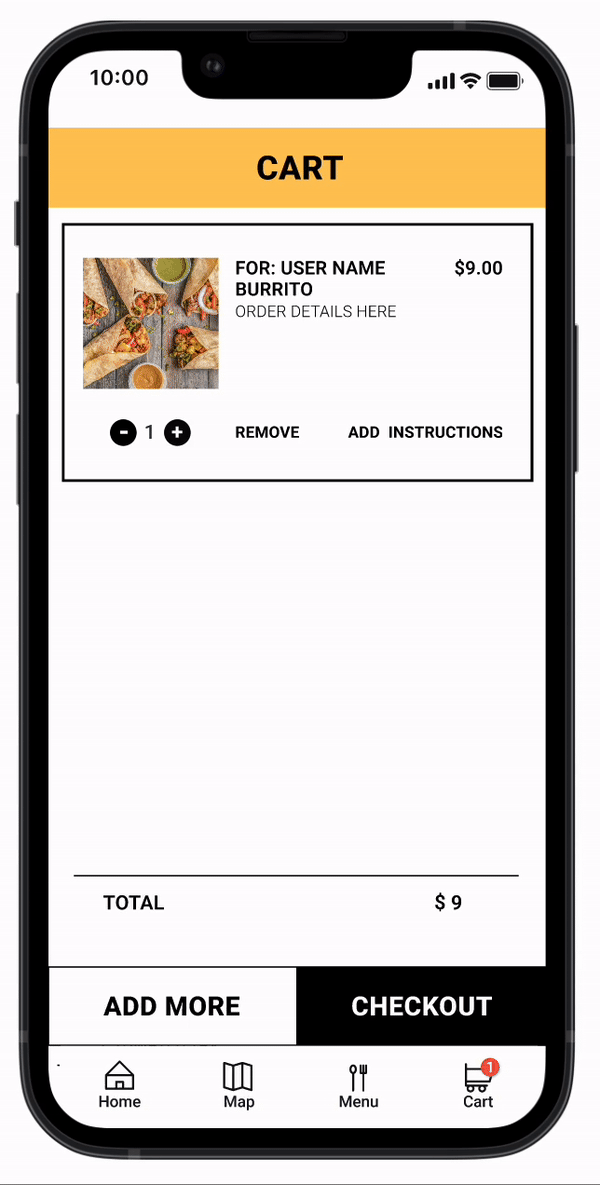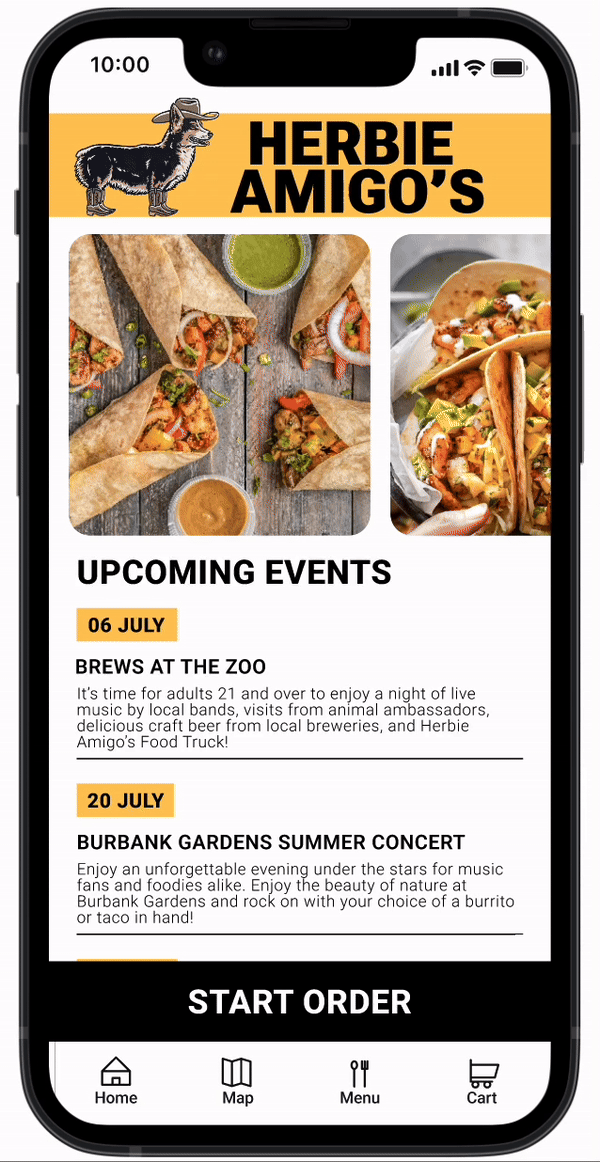
Living with a dietary restriction or food allergy can make eating out or socializing with friends/family difficult.
Lack of customization features unique to those with dietary restrictions is a problem. This underrepresented group of users deserve to order out without worrying about cross contamination or getting sick. This project sets out to help give these users a platform to communicate their needs.
Convenience is a priority. What can be done to make this process as efficient as possible? This UX project also aims to improve transparency of food truck wait times to communicate accurate pick up time estimations.
My name is Allison Domgard and I am the lead UX designer and researcher of Herbie Amigo's Mexican Food Truck app. This project was created as a case study for my Coursera Google Certificate Course.
I conducted five in-person interviews and two separate usability studies for both low fidelity and high fidelity prototypes to better understand the users.
Following my initial interviews, I compiled a list of user pain points and created user personas to represent subgroups of my target audience. I also performed a competitive analysis to get a better insight on competitor strengths and weaknesses.
A series of storyboards and wireframes were created to establish a foundation of the app's structure. This rough draft went through many changes throughout the design process, transforming from low fidelity mock ups to a high fidelity prototype. I'm excited to show you more of the process below.
I conducted interviews to better understand user goals and frustrations when ordering food from online apps. A user group identified through research includes those with food allergies or dietary restrictions. Many apps lack equity focused design to cater to these underrepresented groups.
Research also supports the assumption that user's seek convenience when ordering from online apps. Accessibility to allergy safe options, proper labeling, and open communication is important to those ordering with dietary restrictions. Other user problems include inaccurate pick up times, incomplete orders, and lack of transparency.
When I dine-in, I can communicate my dietary restrictions. Most of the time it is difficult or impossible to do so on an app.
Clearly marking allergy-safe/friendly options and allowing for special instructions would help make me feel safer.
Restaurants should be more transparent and be able to provide specific details in the app so it’s very similar to ordering in the store.
ABOUT
Brittany is a busy professional working in Dallas, Texas. She likes to order food for convenience, however her options are limited due to dietary restrictions. She is frustrated with limited options, insufficient labeling, and poor communication. She prefers to order online for pick up because she does not always have time for a sit down meal.
GOALS
-
Ordering online with convenience
-
To have access to gluten free options
-
A way to communicate her individual needs
-
To avoid risk of cross contamination
PAIN POINTS
-
Difficulty knowing what is gluten free on the menu
-
Unable to customize order
-
Not enough time to order and pick up lunch before work meeting
USER PERSONA
AGE
JOB TITLE
STATUS
EDUCATION
LOCATION
35
VP OF DIGITAL
OPERATIONS
MARRIED
BACHELOR'S
DALLAS, TX

ABOUT
Ryan enjoys going out to eat with his fiance and experiencing the social night life in Dallas, Texas. He is frustrated with inaccurate pick up estimations and the uncertainty of his order status. This can result in wasted time and unnecessary waiting.
GOALS
-
Would like a better way to track the status on his meal
-
Better communication between restaurant and customer
PAIN POINTS
-
Inaccurate pick up estimations
-
Incomplete or incorrect orders
-
Long wait times that are not properly communicated
USER PERSONA
AGE
JOB TITLE
STATUS
EDUCATION
LOCATION
25
ASSET MANAGER
ENGAGED
BACHELOR'S
DALLAS, TX

“Restaurants should be more transparent and be able to provide specific details in the app so it is similar to ordering in the store.”
“It is already difficult to maintain a diet with restrictions, so when it is difficult or impossible to make customizations or find suitable options, I often won’t order from that restaurant.”



A competitive analysis was conducted to investigate the customization features of three different competing restaurant apps. Are they allergen friendly? What kind of customizations do they offer? I also analyzed the user flow and whether competitors provided pick up estimations. Although they all had areas for special instructions or additional comments, Chipotle was the only restaurant to include nutritional/allergen preferences.
MEXICANA
DELEON'S TACO RICO
_edited.png)






_edited.png)








_edited.png)
QUESTIONS
I want to learn how easy it is for users to customize orders and complete checkout using the Herbie Amigo Food Truck app.
Herbie Amigo's wants to provide their customers with adequate options (including allergen friendly options) to make for an easy and quick experience.
It is important to know and understand what users find beneficial, unnecessary, or challenging when creating pick up orders.
-
What can we learn from the user flow when a user creates an order?
-
Are there any design changes that can be made to improve user experience?
-
Does the menu provide adequate features for item customization?
-
Do all functions serve a purpose?What challenges can deter a user from completing their order?
-
10 minutes
-
USA (remotely)
-
Unmoderated usability study
-
Users were asked to perform a tasks in both low fidelity and high fidelity prototypes on two separate occasions.
-
5 individuals
-
18-40 years old
-
3 females, 2 males
-
At least three users with a
dietary restriction
In addition to making functional changes to Herbie Amigos, I updated the design style to improve design continuity and enhance visual appeal. Yellow symbolizes joyfulness, happiness, and energy.


_edited.jpg)

1
-
5 out of 5 participants did not like the repetitive pop ups for each ingredient
-
Customization of ingredients will no longer require pop-ups and will stay on one screen
-
This feature will allow user to adjust portion size when building a bowl or burrito
2
COMMUNICATION & TRANSPARENCY
After the usability studies, I was able to determine 5 ways to improve the design and functionality of Herbie Amigo's Mexican Food Truck app.
3
-
4 out of 5 particpants want to be able to add special instructions
-
Created feedback tool to allow communication back to the user
-
Users will not be forced to go through allergy special instructions if it is not applicable to them.
PROVIDE LIST OF
INGREDIENTS AND
POTENTIAL
ALLERGENS
-
All 3 of the participants with dietary restrictions want clear labeling
-
Users can click the allergy tab at the bottom of each menu option to learn about the ingredients in the selected meal
4
5
-
2 out of 5 users said they order meals for the entire family
-
Since each user may have different needs, they can designate their own special instruction
-
This will make allergy customization unique to each user
-
5 out of 5 participants want to know pick up time estimations before ordering
-
Users can opt for text message updates to get status updates on their order and be provided current estimation times will be posted during checkout

1
To reduce pop up redundancy, I created an option switcher that lets the user choose between none, light, regular, and extra portion sizes. On the low fidelity prototype, the user had to choose portion size on a pop up for every item they selected.


2
Allergy information is now provided to increase transparency about the ingredients. Each list is individualized to the selected item.


3
To improve communication, I added a button for allergy users to address concerns (located on the cart screen). I wanted to avoid unnecessary pop ups for the non-allergy users. This will allow users to click it if they want, but will not be forced to go to that screen.
On this screen I provided a text box tool to add special instructions. If requests cannot be completed, the user can choose from options to determine the next steps.

4
All participants voiced concerns over the need of accurate pick up time estimations. Before the user starts their online order, a pop up will show the current wait time, If the food truck is very busy, food truck employees can update the time frame, so users will be informed prior to purchase. Text message feature was also added to improve communication about order status.


5
To avoid confusion about different meal orders, a pop up was created so that each meal added to the cart will have an owner or name it belongs to. This will make allergy customizations unique to each user.


Herbie Amigo's was the first project I created as part of my UX Design Google Certificate Course. Although it is not a real restaurant, it gave me the opportunity to test my design and research skills. I look forward to future experiences in which I can be apart of a design team to brainstorm and test ideas with others. I determined 3 main takeaways to this case study:
1) It was important that the allergen/dietary features did not disturb the flow or become an inconvenience for non-allergy users.
2) I did not have the opportunity to work with anyone else (ex: stakeholders, engineers, etc.) during this project. Since this was not for a real client, I did not get the full experience.
3) I taught myself how to create interactive components and use different variables in Figma. This was frustrating at times, but very rewarding to learn advanced concepts.
.png)
.png)
.png)


.png)






